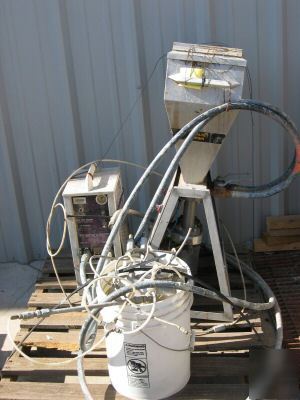|
Lily High Pressure (2000PSI) Epoxy Injection System The Gold standard for wood and concrete restoration! Lily TA-25 dual 7-gallon hopper feeder, CD-15 transfer unit and A-118 Gusto Purge Tank. Read the operator's manual HERE in pdf format. Discover the world of applications Here Any CD dispenser can be employed to inject abrasive-free gel viscosity epoxies. Unlike the injection of low viscosity resins that normally use a single line to transfer the resin from the mixer to the port, gel injection requires the use of twin lines. This is because the heavier viscosity components flow much more slowly than thin resins, increasing the risk of their setting up in-line. The twin lines merge into a manifold and steel mixer usually located at the port connection. The mixer is usually of a larger diameter than that used with thin materials in order to reduce the pressure loss. The compact TA25 features two 7-gallon hoppers poised over twin piston pumps that deliver 1,100 psi. The hoppers, gratings, weather tight lids, and frame are stainless steel. The unit is 24†x 12†in length and width, and weighs 80 pounds. The TA25 is suitable only for viscous resins. The CD15 was designed specifically for the injection of two component resins into cracks and similar voids in concrete. Over twenty years of injection field experience on the part of the designers urged an overwhelming concern for ratio reliability under the most adverse construction site conditions that could be imagined. This concern transcended all other considerations in the development of the CD15. As a result, the CD15 features: * four two way actuated ball valves... rather than check valves, or three way valves that allow overlapping flow of components * patented COCO™ mechanical sequencing of fluid valves... rather than actuation by springs on fluid pressure * pressurized resin supply for positive filling of metering cylinders... rather than gravity or vacuum * sensors that assure complete filling of metering cylinders regardless of resin viscosity or temperature… rather than arbitrary lag-time settings * piston displacement of the resin components... rather than gears that allow slippage of fluids * A cycle counter to schedule maintenance so that worn parts are replaced before they fail… rather than after they fail * ratio setting determined by precision machined piston surfaces... rather than variable settings prone to slippage * proportioning regulated by relative diameter of pistons... rather than relative rate of travel * resin path that allows no air entrapment... rather than vents to bleed entrapped air periodically These features combine to assure precise proportioning regardless of ratio, viscosity of the components, or dispense pressure. The proportioning accuracy of the CD15 is as precise at 11:1 for example, as at 1:1. These components comprise the Gel Conversion Kit. It includes a 1/2†diameter 24 element stainless steel mixer and two 3/8†twin dispense lines twelve feet long. Cleanup is limited to the manifold and mixer. The Gusto Purge Tank procedure is used. Pressurized vessels are adequate to transfer thin resins into a CD dispenser. However gel viscosity products usually require transfer pressures of 600 psi and often higher in cool temperatures. Pumps are required. There are many drum and pail pumps that can be used. Lily Corporation is a distributor of Aro Ingersoll Rand and Graco for examples. Another option is the Lily TA-25 twin pump assembly. Because the resin components do not merge until they are within the mixer, cleanup is limited to the mixer and downstream tubing and port valves. With Gusto, it is easy. The mixer is removed from the dispenser and attached to the mating fittings on the Gusto solvent tank. The tank is pressurized by relocating the air supply fitting from the dispenser to the tank. A 3-way directional valve directs air into the mixer, purging the resin accumulations. The tank is then manually shaken to splash small solvent bursts into the air stream without significantly choking its velocity. The solvent acts as an abrasive, scouring the components squeaky clean. There is no flushing with large volumes of solvent or disassembly of individual components. Only a few ounces of solvent are required for cleanup. Following cleanup, the mixer is stowed submerged in solvent within the tank until its next use, even if months away. Most injection resins can be left in the dispenser indefinitely. Ad Created With Dominant Ad Creator 2.3.2 Now, our very own "fine print:" (please look at our rules and privacy policy) |
C-Le@machine--tools.com (Charmaine Le) for additional information. This email is used for forwarding to newsgroup user.
